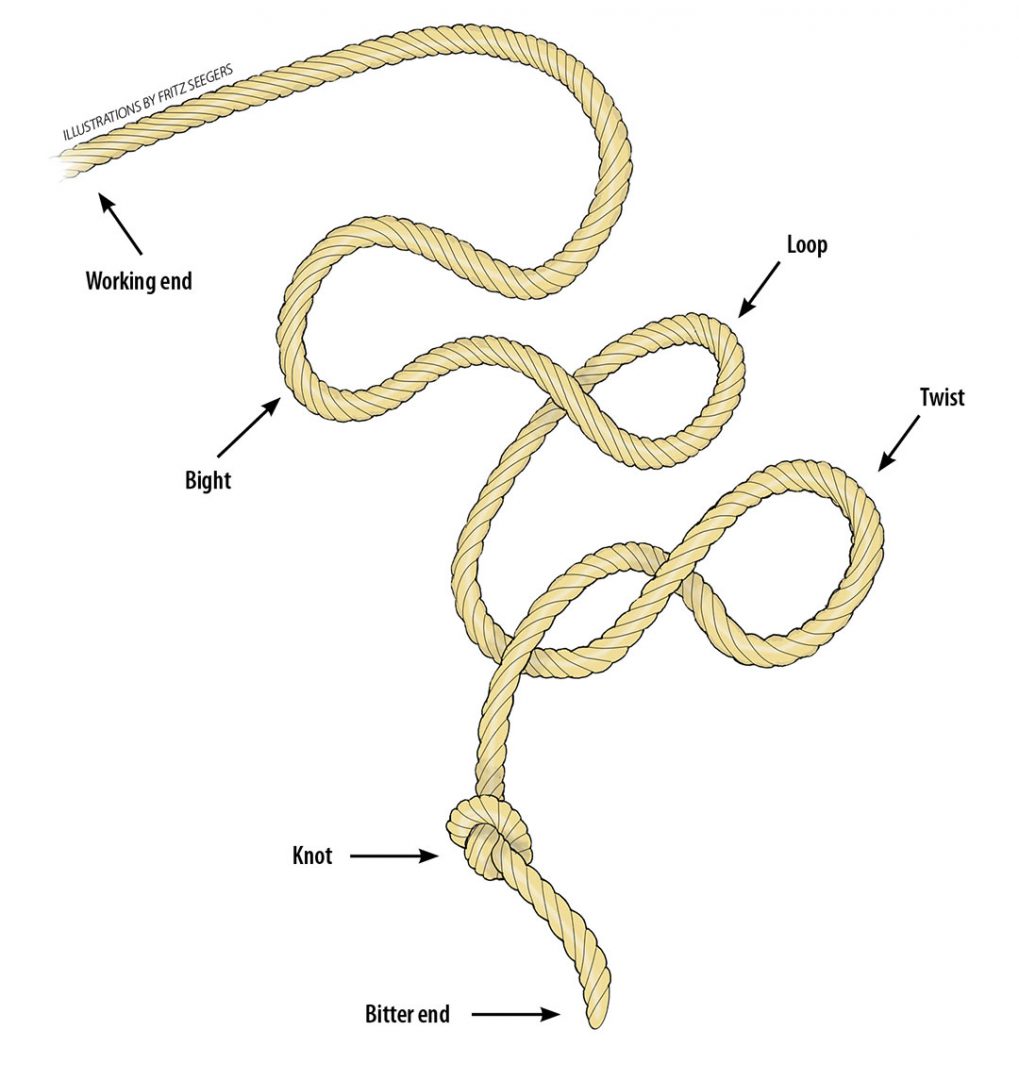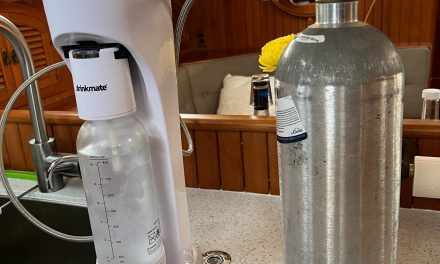The world of ropes and lines is woven with its own terminology that draws on a deep history.

Issue 135: Nov/Dec 2020
Make fast, slack off, cast off, take a turn, reeve: These are just a few of the ways that sailors describe putting rope to work on a vessel. Aboard Briney Bug, we use all of these terms, because there is a lot of rope aboard, doing a lot of things. We like the efficacy and versatility of cordage. It’s economical, easy to use, available just about anywhere, and has a salty look for which there is no substitute. In our minds, it bears learning a little bit about something so integral to sailing. Let’s start with the word itself.
Rope or Line?
Many sailors love to say that aboard a boat, there is no rope. We’ve also been known to make this rather rigid statement, but Clifford W. Ashley—author of the definitive The Ashley Book of Knots, published in 1944 and enumerating on the anatomy, terminology, and ability of over 3,900 knots—begs to differ.
“There is an old saying that there are only seven ropes aboard a ship, but there are actually over sixty that have borne the name,” he writes. Ashley goes on to list a few: man rope, bell rope, foot rope, boltrope, tiller rope, bucket rope, clew rope, grab rope, tow rope, and wheel rope. Ashley does offer that, “the word rope is seldom heard on shipboard, where it generally refers to new stuff in unbroken coils.” But he then adds that, “rope is also the inclusive term applied to all cordage.”
For those of you unsettled, Chapman Piloting, Seamanship and Small Boat Handling assures, “Rope once in use onboard a boat is called line, or by name of the rigging part it has become.” Choose your authority.
When is rope too small to be rope? When is it twine, for example? The dividing line between what’s referred to as “small stuff” and rope also varies among authorities, with Ashley placing it at anything less than one inch in circumference. To save you a trip to the calculator, that’s roughly anything smaller than 5/16-inch diameter line…err, rope.

Terms of Ropeology
To avoid confusion, when putting rope to work it’s useful to know (and agree on) some basic terms.
Working end: In his book The Knot Bible, Nic Compton defines the working end as “the active end” of a knot while it is being tied, “whereas the end not in use is called the standing end.” Ashley does not make specific reference to this term, but Compton’s definition seems standard across other rope references.
Bitter end: Not just a famous yacht club in the British Virgin Islands, the bitter end literally refers to the end of a rope (or cable) that has been turned around the ship’s bitts: “The end of the cable abaft the bitts is the ‘bitter end,’ ’’ writes Ashley. “The common expression, ‘reached the bitter end,’ refers to a situation of extremity and has nothing at all to do with lees and dregs and other unpalatable things. It means literally that someone has ‘got to the end of his rope.’ ’’ In common rope parlance today, the bitter end is used synonymously with the standing end, or the end of a rope that is tied off.
Standing part: The inactive or part of a rope not in use, sometimes called a tail.
Bight: A curved section of rope, distinct from the ends and the standing part.
Loop: A circle formed in a rope by crossing the ends of a bight.
Twist: Two or more successive loops in a rope.
Cast off: To remove a rope from where it’s secured so that it can run free.
Coil: To wind rope in a series of loops, usually for neat stowage.
Slack off, ease off, or surge: To let rope out to lessen tension, at least temporarily, such as when increasing the length of that portion of a rope under tension.
Haul: To pull on a rope by hand.
Make fast: To secure a rope so that it can hold tension.
Reeve: To pass an end of a rope through any hole or opening, such as through a block.
Stand by: To take hold of a rope and stand ready to haul, cast off, or slack off.
Snub or take a turn: To put at least one wrap of rope around a pin, post, bitts, or cleat to temporarily allow the rope to hold tension. (An interesting fine point about the word bitts: While bitts, plural, is a noun referring to the upright timbers or posts to which lines are made fast, the singular “bitt” is a verb which means to take a turn around the bitts.)
Handsomely: To do something with rope slowly, carefully, gently, or gradually.
Smartly: To do something with rope precisely and with alacrity.
Knots and Their Cousins
Ashley defines a knot as any complication in cordage, except accidental complications (such as snarls and kinks), or complications adapted for storage (such as coils, hanks, or balls). Ashley also puts bends, hitches, splices, and sinnets in another category of knots.
Bends: Used to tie two rope ends together.
Hitches: Used to secure a rope to another object or to another rope if inert. It’s of interest to note that there is only one “slippery hitch,” but many hitches can be slipped along the ropes to which they’re tied.
Splices: Used to secure two ropes or two parts of the same rope together by intertwining their strands.
Sinnets: Flat braided cordage, such as tied to form zipper pulls. (According to Ashley, sinnet line is “the original name for braided rope, used at sea for signal halyards as early as 1860.”)
Except for use in a playground game of jump rope or tug of war, it’s difficult to make use of cordage without some form of knot, bend, hitch, splice, or sinnet being involved. Every rope has at least one specific purpose just waiting to be formed.
The Go-To Knot
Knots are as diverse as people, so it stands to reason that individual sailors have one or two knots that they hold dear as their all-purpose go-to. Though we are able to tie a variety of knots quickly, easily, and accurately, on our boat we find we most frequently use the rolling hitch. The rolling hitch is simple to learn and can be employed aboard to do just about any job for which a knot is required. It is secure, adjustable, and can be untied while under a load. These qualities make it ideal, for instance, for hitching a snubber to a rode, whether the rode is rope or chain. For sailors with only enough motivation to learn one knot, in our experience the rolling hitch is a most worthy candidate. Sorry, bowline.
Rope and Knot Resources
- Cordage Institute: ropecord.com
- The Ashley Book of Knots, Clifford W. Ashley
- The Complete Rigger’s Apprentice: Tools and Techniques for Modern and Traditional Rigging, Brion Toss
- The Knot Bible—The Complete Guide to Knots and Their Uses, Nic Compton
- The International Guild of Knot Tyers: igkt.net
- The Complete Book of Knots, and The Ultimate Encyclopedia of Knots and Ropework by Geoffrey Budworth
Rudy and Jill Sechez have been living aboard and cruising since 1997 and are the authors of Anchoring—A Ground Tackler’s Apprentice. They are available for coaching, training, and presenting on a range of boating topics at trawlertrainingabc.com.
Thank you to Sailrite Enterprises, Inc., for providing free access to back issues of Good Old Boat through intellectual property rights. Sailrite.com





